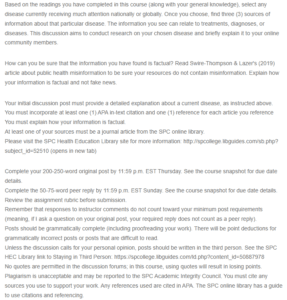Cardiovascular Diagnosis and Treatment
Introduction
Cardiovascular disease (CVD) is a term that comprises various heart illnesses such as high blood pressure, coronary heart disease, and rheumatic heart disease. These conditions are currently the primary cause of death globally. CVDs can develop all through one’s lifespan without showing symptoms. High blood pressure is a primary risk factor for CVD and has caused over 10 million deaths worldwide over the last five years (Liuzzo & Patrono, 2021).
Diagnosis of CVDs
Electrocardiogram (ECG). It is a rapid test that registers the rhythm and electrical motions of the heart. It tells how fast or slow the heart is beating. A Holter monitor is a portable ECG device that a patient puts on for a day to record the daily activities of the heart. Unlike a regular ECG test, the test records uneven heartbeats (Zhai et al., 2022).
Treatment of CVDs
Treatment of CVD depends on the root and kind of heart impairment. Severe heart damage requires surgical procedures. Embracing healthy lifestyle practices is crucial, including eating low-fat meals, little-salt diets, exercising regularly, and getting enough sleep, which are vital parts of treatment. Medications can also help in handling CVD symptoms and prevent further complications. The type of medication is specific to the nature of the heart illness (Liuzzo & Patrono, 2021).
Data on the Impact of CVDs
Centre and Disease Control (CDC) reports that at least one person dies from CVD every 34 seconds in the USA (Liuzzo & Patrono, 2021). World Health Organisation says that Approximately 697,000 people in the USA succumbed to heart disease between the years 2020 and 2021. This translates to 1 in every five deaths cases caused by heart disease. Roughly $229 billion in 2020 and 2021 has been used in the United States to treat and manage CVDs (Tsao et al., 2022).
The information about CVDs in this paper is valid and factual because it was obtained from journals and articles published within the last five years. Secondly, it is obtained from peer-reviewed journals; the data was obtained from government-recognized websites such as CDC and WHO.
References
Liuzzo, G., & Patrono, C. (2021). A fixed-dose combination treatment strategy to reduce premature cardiovascular disease deaths globally. European Heart Journal, 43(1), 16–17. https://doi.org/10.1093/eurheartj/ehab749
Tsao, C. W., Aday, A. W., Almarzooq, Z. I., Alonso, A., Beaton, A. Z., Bittencourt, M. S., Boehme, A. K., Buxton, A. E., Carson, A. P., Commodore-Mensah, Y., Elkind, M. S. V., Evenson, K. R., Eze-Nliam, C., Ferguson, J. F., Generoso, G., Ho, J. E., Kalani, R., Khan, S. S., Kissela, B. M., … on behalf of the American Heart Association Council on Epidemiology and Prevention Statistics Committee and Stroke Statistics Subcommittee. (2022). Heart Disease and Stroke Statistics—2022 Update: A Report From the American Heart Association. Circulation, 145(8). https://doi.org/10.1161/CIR.0000000000001052
Zhai, J., Ji, Z., Jin, X., Du, X., Cao, L., & Zheng, W. (2022). Meta-Analysis of the Effect of Honghua Injection in Treating Coronary Heart Disease Angina Pectoris. Evidence-Based Complementary and Alternative Medicine, 2022, 1–11. https://doi.org/10.1155/2022/4537043
ORDER A PLAGIARISM-FREE PAPER HERE
We’ll write everything from scratch
Question
Based on the readings you have completed in this course (along with your general knowledge), select any disease currently receiving much attention nationally or globally. Once you choose, find three (3) sources of information about that particular disease. The information you see can relate to treatments, diagnoses, or diseases. This discussion aims to conduct research on your chosen disease and briefly explain it to your online community members.

Cardiovascular Diagnosis and Treatment
How can you be sure that the information you have found is factual? Read Swire-Thompson & Lazer’s (2019) article about public health misinformation to be sure your resources do not contain misinformation. Explain how your information is factual and not fake news.
Your initial discussion post must provide a detailed explanation about a current disease, as instructed above.
You must incorporate at least one (1) APA in-text citation and one (1) reference for each article you reference
You must explain how your information is factual.
At least one of your sources must be a journal article from the SPC online library.
Please visit the SPC Health Education Library site for more information: http://spcollege.libguides.com/sb.php?subject_id=52510 (opens in new tab)
Complete your 200-250-word original post by 11:59 p.m. EST Thursday. See the course snapshot for due date details.
Complete the 50-75-word peer reply by 11:59 p.m. EST Sunday. See the course snapshot for due date details.
Review the assignment rubric before submission.
Remember that responses to instructor comments do not count toward your minimum post requirements (meaning, if I ask a question on your original post, your required reply does not count as a peer reply).
Posts should be grammatically complete (including proofreading your work). There will be point deductions for grammatically incorrect posts or posts that are difficult to read.
Unless the discussion calls for your personal opinion, posts should be written in the third person. See the SPC HEC Library link to Staying in Third Person: https://spcollege.libguides.com/ld.php?content_id=50887978
No quotes are permitted in the discussion forums; in this course, using quotes will result in losing points.
Plagiarism is unacceptable and may be reported to the SPC Academic Integrity Council. You must cite any sources you use to support your work. Any references used are cited in APA. The SPC online library has a guide to use citations and referencing.
Follow the Discussion Forum Tutorial as a guide for proper formatting.
Resource for this assessment:
Swire-Thompson, B. & Lazer, D. (2019) Public health and online misinformation: Challenges and recommendations. Annual Review of Public Health, 41, 433-451. https://www.annualreviews.org/doi/10.1146/annurev-publhealth-040119-094127


